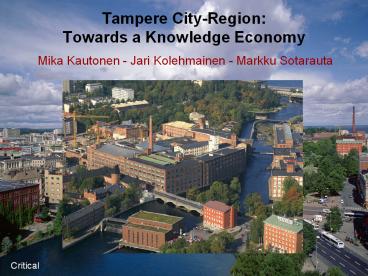Tampere City-Region: Towards a Knowledge Economy PowerPoint PPT Presentation
Title: Tampere City-Region: Towards a Knowledge Economy
1
Tampere City-Region Towards a Knowledge Economy
- Mika Kautonen - Jari Kolehmainen - Markku
Sotarauta
Critical
2
Tampere city-region overview
- TAMPERE REGION
- population 445,500
- 9 of Finlands population
- GRP per capita 3rd highest
- GRP 19,200 EUR (1999)
- EU 15 GRP index 100 in Tampere 94.9 (2000), 88.3
(1995) - TAMPERE CITY-REGION
- population 300,000
- the 2nd largest regional centre
- City of Tampere, town of Nokia and municipalities
of Ylöjärvi, Kangasala, Lempäälä, Pirkkala and
Vesilahti - TAMPERE CITY
- population 200,000
3
Tampere City Region
4
Tampere city-region from manufacturing to
services
- Industry to develop in the 19th century
manufacturing of textile and clothing - At the end of the century, 69 of industrial
employees in textile industry, 13 in pulp and
paper industry and 8 in metal industry - Reparations after World War II contributed to the
growth of metal industry - In the 1960s, textile, clothing, leather and shoe
industries employed 38, metal industry 31 and
pulp and paper industry 14 - In the early 1980s reorganizations, spin-offs and
specialization - Collapse of the Soviet trade affected traditional
industries
5
Tampere city-region from manufacturing to
services
- recession from the early 1990s
- growth of information and telecommunication
technology and KIBS sectors (Nokia Group alone
3.600 in RD) - in 2000, textile, clothing, leather and shoe
industries employed 4, metal products and
machine building together 26 (9.800 employees),
pulp and paper industry 11, and electronics 9
of industrial employees (total manufacturing
employment 32.000) - in comparison, so-called KIBS sector alone 19.000
employees (software and computer services,
technical services, consultancy, RD services,
private training etc.)
6
Roots of local competitiveness
- Educated population in Tampere city-region
- of total adult population (gt15 years), 64.5 at
least secondary level degree, and 26.5 HEI
degree (nat. average of 59.4 and 23.3 ) - number of university students about 25.000
- RD intensity
- RD investments 14 per cent of national spending
- 25 real annual change 1995-1999 (nat. average
14) - growth particularly in the business sector
- share of RD personnel of the workforce high,
4.6 (nat. average 3.1) - Nevertheless, Helsinki Region dominates RD
expenditures with a share of 45 strongly.
7
Knowledge Centres in Tampere
8
The basics of digital media agglomeration in
Tampere
- roots quite far in history, but the real
emergence and rapid growth in the 1990s (5.000
employees in 1996 -gt 10.000 in 2000) - the business structure very diverse, but
dominated by the business units of large,
internationalised ICT companies (especially Nokia
Group) - major strengths strong large companies,
educational institutions and science and
technology base - major weakness weak entrepreneurial atmosphere,
the paucity of (new) companies aiming at fast
growth and internationalisation - digital media has been one of the most important
focus areas of local business development and
innovation policy -gt large eTampere Programme
(appr. EUR 130 million) for five years.
9
(No Transcript)
10
Cosmopolitanism and image
- traditionally, Finland has been a closed society
with a very homogenous population - access to the EU -gt increased in- and
outmigration, immigrants - yet, images of Finland and especially its urban
regions outside of the Capital region were not
particularly prominent in the foreign experts
field of choices (Raunio 2002) - several nation-wide polls consistently shown that
as a city to live in, Tampere rated highest of
all cities in Finland - based on e.g. increase of jobs, central location
and good connections, and the cultural amenities
of the city (e.g. theatres, festivals,
congresses).
11
Social polarisation
- economic crisis of the early 1990s had serious
social consequences for Tampere city-region as
the unemployment rate skyrocketed to over 20 per
cent - despite economic growth unemployment rate is
still over 10 (12,9 in 2001, whole country
12,0) - about 25 of the unemployed long-term unemployed
and among them every second unemployed for more
than two years - skills mismatches of the transformation period
-gt permanent problem? - 60 per cent of the long-term unemployed 50 years
old or older, risk especially high in
manufacturing sectors.
12
Sustainability
- during the 1990s, rise of the environmentalism,
environmental awakening - local environmental movements key actors in
process of change by challenging the local
political traditions/culture and especially the
tradition of local governance, called
brothers-in-arms axis - City of Tampere with a holistic environmental
management system based on ISO 14001 - Tampere Forum to stimulate local democracy and to
activate citizen participation in sustainable
development (est. 1996), a bottom-up approach.
13
Governance
- in Finland, trend of the 90s the increasing
sub-regional co-operation between municipalities - reasons, e.g. new Regional Development Act
(1994), small size of municipalities - local government gained more importance in
regional policy. The new Act splits the
responsibility for institutional regional
development efforts between state and
municipalities - sub-regions form the smallest regional policy
unit - sub-regional co-operation significant part of
local activities, yet experiences and success
vary greatly.
14
Strategies focus on
- Health care technology (Finn-Medi ltd)
- ICT (Tampere Technology Centre ltd)
- Automation and mechanical engineering (Tampere
Technology Centre ltd) - Media communication (MediaTampere ltd)
- KIBS (Professia ltd)
- Tourism
- City of Tampere is building institutions,
infrastructure,and is co-ordinating the
development network etc.
15
(No Transcript)
16
Some conclusions
Concept of a comprehensive business development
policy by the City of Tampere from 1998 many
integrative aspects already acknowledged, however
operationalisation slower.
17
Some conclusions
- several of the proposed challenges are well
acknowledged in Tampere city-region, including
learning- and innovation-based competitiveness,
image of the region, and social inclusion - cultural aspects increasingly seen important also
for the local economic development - cosmopolitanism considered very important, yet
maybe most challenging among the policy-makers - sustainability-related matters usually conceived
as a part of separate policy domain.

